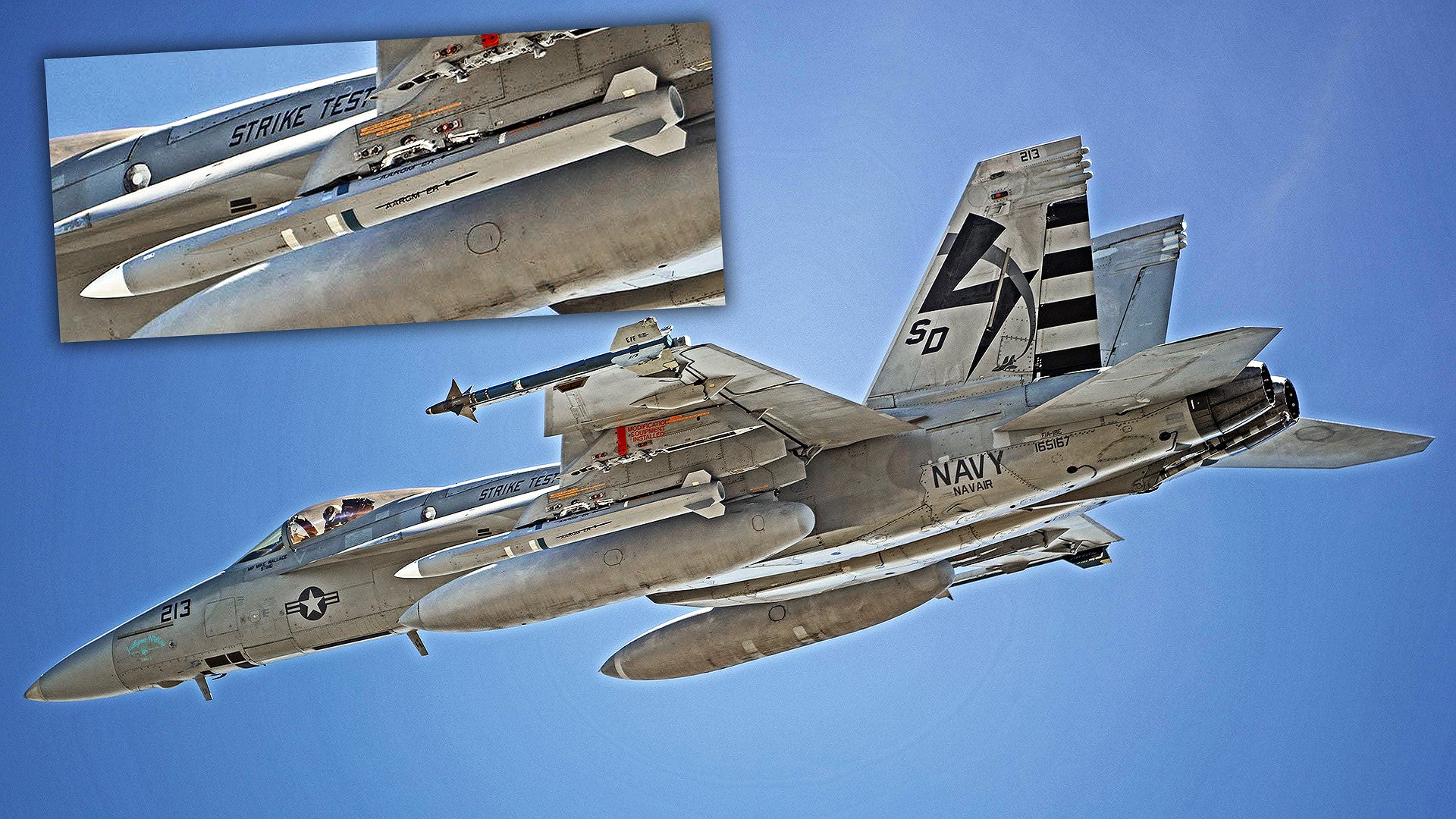The U.S. Navy has announced that an F/A-18E Super Hornet carried a prototype of the AGM-88G Advanced Anti-Radiation Guided Missile-Extended Range, or AARGM-ER, aloft for the very first time. The test flight took place at the Patuxent River Test Range in Maryland earlier in the week.
The Navy’s Air Test and Evaluation Squadron 23 (VX-23), based at Naval Air Station Patuxent River, provided the F/A-18E for the test. The AGM-88G prototype involved was a captive carry test article, meaning that it was not capable of being launched and lacked other key systems that will be found on the final missiles, such as their guidance package and warhead. The captive carry test flight gathered data on how the aircraft performed with the weapon under its wing, as well as the stresses and strains on the missile itself as the jet went through a series of maneuvers, according to a press release from Naval Air Systems Command (NAVAIR).
“This first flight represents a significant step in the AARGM-ER Engineering and Manufacturing Development phase,” Navy Captain Mitch Commerford, head of NAVAIR’s Direct and Time Sensitive Strike program office, said in a statement on June 2. “Data collected from this testing will inform the planned build-up and overall expansion of flight testing with AARGM-ER.”

Development of the AGM-88G, which The War Zone
has reported on extensively in the past, began in 2015. The missile offers significant improvements over the existing and already highly capable AGM-88E Advanced Anti-Radiation Guided Missile (AARGM). Orbital ATK, which developed the AARGM, was responsible for work on the AARGM-ER until 2018, when Northrop Grumman bought the company, renaming it Northrop Grumman Innovation Systems in the process, which is now the primary contractor for the AGM-88G.

The AGM-88G actually uses the same guidance and control sections as the earlier AGM-88E, but put it in a sleeker body together with a new rocket motor, warhead, and control surfaces in the tail. Though the Navy has not released specific details, it has said that the new AARGM-ER will be significantly faster and longer range than its predecessor. The present AARGM missiles have a maximum range of around 80 miles and can hit Mach 2 during a high-speed sprint in the terminal stage of their flight, according to publicly available information.


The AARGM-ER’s primary task, as is the case with the AARGM, will be the suppression and destruction of enemy integrated air defense networks, homing in on hostile radars and other emitters associated with surface-to-air missiles and other air defense systems. However, it’s guidance package is multi-mode guidance, with a GPS-assisted inertial navigation system component to get to the general target area at extended ranges and a millimeter-wave radar capable of locating targets, even if they shut down and stop emitting signals to zero in on.
The guidance package is networked, too, so the launching aircraft can fire it without having to first acquire the target’s emissions, if at all. The off-board sources beyond the plane that fires it can feed updated targeting information the missile in flight. The weapon is reportedly able to relay data back in its final moments about whether it successfully struck the target or not, too.

All of this means that the new missile will have a general air-to-surface capability, too. The AGM-88Es, which, as noted, has the same multi-mode guidance system, have already given the Navy, as well as the U.S. Air Force and other operators around the world, a highly capable and precise weapon for engaging various targets down below.
The Navy plans to initially field the AGM-88G on its F/A-18E/F Super Hornets and EA-18G Growlers by 2023, but the missile is also designed to fit inside the internal bays on the service’s F-35C Joint Strike Fighters. You can read much more about AARGM-ER, its capabilities, and what it means for the Navy, as well as the Air Force, which is also planning to integrate this missile internally on its F-35As, in these past War Zone pieces.

The AGM-88G body is also designed to be modular, allowing for the rapid integration of new and improved capabilities to the missile in the future, such as changes to optimize it for the anti-ship role, which you can read about more in this previous War Zone story. This has also made the basic design readily adaptable to other mission sets and the Air Force is already developing its own derivative, known as the Stand-in Attack Weapon, or SiAW, as a time-sensitive strike weapon against targets on land. You can read more about the SiAW project in this past War Zone piece.
Northrop Grumman has also explored a ground-based, containerized launcher capable of firing both the AGM-88E and AGM-88G. You can read more about that system, which The War Zone was first to report on, here.

This all makes this first flight test of the AARGM-ER all the more exciting a development for the Navy, as well as the Air Force and other foreign countries, including those that already field the AARGM, that might be watching the program with interest.
Contact the author: joe@thedrive.com
